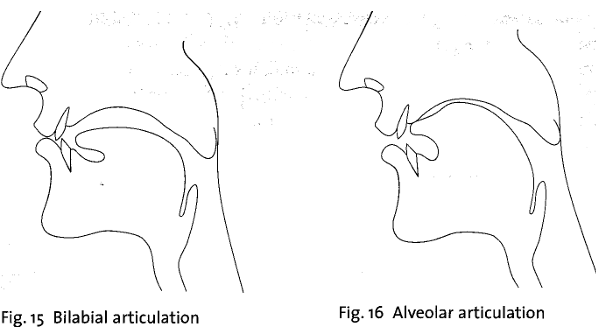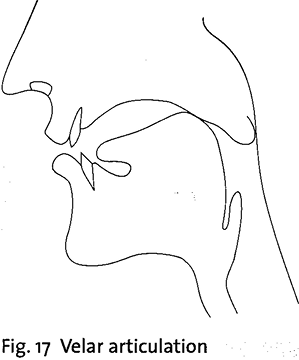


 Grammar
Grammar
 Tenses
Tenses
 Present
Present
 Past
Past
 Future
Future
 Parts Of Speech
Parts Of Speech
 Nouns
Nouns
 Verbs
Verbs
 Adverbs
Adverbs
 Adjectives
Adjectives
 Pronouns
Pronouns
 Pre Position
Pre Position
 Preposition by function
Preposition by function 
 Preposition by construction
Preposition by construction
 Conjunctions
Conjunctions
 Interjections
Interjections
 Grammar Rules
Grammar Rules
 Linguistics
Linguistics
 Semantics
Semantics
 Pragmatics
Pragmatics
 Reading Comprehension
Reading Comprehension|
Read More
Date: 2024-10-24
Date: 2024-11-11
Date: 2024-10-12
|
English has six plosive consonants: p, t, k, b, d, g. The glottal plosive ? occurs frequently but it is of less importance, since it is usually just an alternative pronunciation of p, t, k in certain contexts. The plosives have different places of articulation. The plosives p, b are bilabial since the lips are pressed together (Fig. 15); t, d are alveolar since the tongue blade is pressed against the alveolar ridge (Fig. 16). Normally the tongue does not touch the front teeth as it does in the dental plosives found in many languages. The plosives k, g are velar; the back of the tongue is pressed against the area where the hard palate ends and the soft palate begins (Fig. 17).
The plosives p, t, k are always voiceless; b, d, g are sometimes fully voiced, sometimes partly voiced and sometimes voiceless. We will consider what b, d, g should be called later.
All six plosives can occur at the beginning of a word (initial position), between other sounds (medial position) and at the end of a word (final position). To begin with we will look at plosives preceding vowels (which can be abbreviated as CV, where C stands for a consonant and V stands for a vowel), between vowels (VCV) and following vowels (VC). We will look at more complex environments later.

i) Initial position (CV): The closing phase for p, t, k and b, d, g takes place silently. During the compression phase there is no voicing in p, t, k; in b, d, g there is normally very little voicing - it begins only just before the release. If the speaker pronounces an initial b, d, g very slowly and carefully there may be voicing during the entire compression phase (the plosive is then fully voiced), while in rapid speech there may be no voicing at all.
The release of p, t, k is followed by audible plosion - that is, a burst of noise. There is then, in the post-release phase, a period during which air escapes through the vocal folds, making a sound like h. This is called aspiration. Then the vocal folds come together and voicing begins. The release of b, d, g is followed by weak plosion, and this happens at about the same time as, or shortly after, the beginning of voicing. The most noticeable and important difference, then, between initial p, t, k and b, d, g is the aspiration of the voiceless plosives p, t, k. The different phases of the plosive all happen very rapidly, but the ear distinguishes clearly between p, t, k and b, d, g. If English speakers hear a fully voiced initial plosive, they will hear it as one of b, d, g but will notice that it does not sound quite natural.

If they hear a voiceless unaspirated plosive they will also hear that as one of b, d, g, because it is aspiration, not voicing which distinguishes initial p, t, k from b, d, g. Only when they hear a voiceless aspirated plosive will they hear it as one of p, t, k; experiments have shown that we perceive aspiration when there is a delay between the sound of plosion and the beginning (or onset) of voicing.
In initial position, b, d, g cannot be preceded by any consonant, but p, t, k may be preceded by s. When one of p, t, k is preceded by s it is unaspirated. From what was said above it should be clear that the unaspirated p, t, k of the initial combinations sp, st, sk have the sound quality that makes English speakers perceive a plosive as one of b, d, g; if a recording of a word beginning with one of sp, st, sk is heard with the s removed, an initial b, d or g is perceived by English speakers.
• Medial position (VCV): The pronunciation of p, t, k and b, d, g in medial position depends to some extent on whether the syllables preceding and following the plosive are stressed. In general we can say that a medial plosive may have the characteristics either of final or of initial plosives
• Final position (VC): Final b, d, g normally have little voicing; if there is voicing, it is at the beginning of the compression phase; p, t, k are always voiceless. The plosion following the release of p, t, k and b, d, g is very weak and often not audible. The difference between p, t, k and b, d, g is primarily the fact that vowels preceding p, t, k are much shorter. The shortening effect of p, t, k is most noticeable when the vowel is one of the long vowels or diphthongs. This effect is sometimes known as pre-fortis clipping.
|
|
|
|
لخفض ضغط الدم.. دراسة تحدد "تمارين مهمة"
|
|
|
|
|
|
|
طال انتظارها.. ميزة جديدة من "واتساب" تعزز الخصوصية
|
|
|
|
|
|
|
بمناسبة مرور 40 يومًا على رحيله الهيأة العليا لإحياء التراث تعقد ندوة ثقافية لاستذكار العلامة المحقق السيد محمد رضا الجلالي
|
|
|